Search: Cyclic Offloading From The Ground And Into Lateral Passing
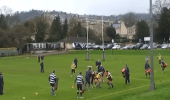 1:03
1:03
Offloads through contact then lateral pass
In groups of 4, players must support each other through a tight channel of tackle shields, before panning out to complete lateral passes to the wing.
 1:12
1:12
Key factors of the lateral pass
An introduction to coaching the lateral pass
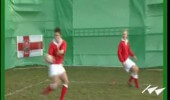 0:37
0:37
What is a lateral pass
To develop the lateral passing and take a look at the fundamental movements
To watch over 2500+ videos join now for free!
JOIN NOW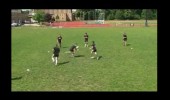 0:35
0:35
Lateral passing & miss pass with follow in 3s
handling progression for developing lines of running and support
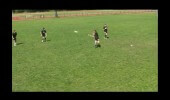 0:32
0:32
Lateral passing & pulling back the pass from wide
Handling Progression for developing the ability to create depth from a flat line
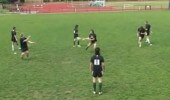 0:21
0:21
Lateral passing in 3s with a switch
A core passing exercise for developing the lateral passing drill
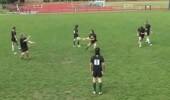 0:13
0:13
Lateral passing in 3s (SM)
A simple lateral passing exercise for all standards. These basic skills are fundamental to rugby and should be repeated using a number of different practises. Key factors : Communication - Present a target with your hands - Run straight - Pass the ball across your body - Realign to repeat
 0:41
0:41
Learning to pass laterally in 4's
Developing our lateral passing skills. The coach can alter the width, depth and number of players
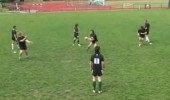
Lateral passing in 3s
Core skills development of teh lateral pass whgilst running
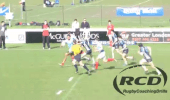 0:29
0:29
Offload Passes
When a solid Filton defence has denied them the outside, Oaklands College are able to break through the line thanks to good running lines from close supporting players and accurate offload passes.
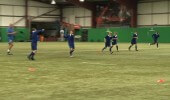
Lateral Pass Variations
Here are different ways to develop a basic lateral pass exercise. Either increase the amount of players, or ask them to start from different positions.
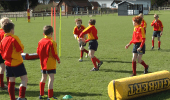 2:09
2:09
Lateral Passing in 3s
A quick exercise to identify ability in catching & passing. Encourage players to have targets up, and to hold their run.
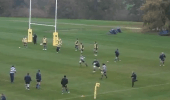 0:58
0:58
Lateral passing in 4s
An essential drill for new players, or a simple but relevant one for experienced players. New players should make sure their passes are not forward and are targeted in front of their teammate's chest. More experienced players can focus on speed of pass and footwork. In this example, a large group is split into two adjacent drills to ensure players aren't stationary for too long.
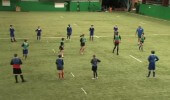 0:47
0:47
Lateral Pass in 5s
This simple drill breaks down the catch and pass while running in a straight line. Players also practice their communication skills.
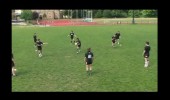 0:13
0:13
Lateral passing in 3s
A core handling exercise that coaches can use to vary the width, depth of pass plus introduce static and live defenders. An exercise repeated at the elite end of the game
 0:14
0:14
Lateral passing in 3s
A great warm up drill and passing exercise.
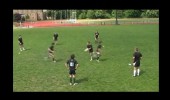 0:20
0:20
Lateral passing & double switch in 3s
A core handling exercise for developing lines of running

Intro to coaching the lateral pass
Basic principles for the coach to focus on
8. Support - Off the Ground reaction pass
Isolated technical practice
Courtesy of the SRU
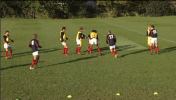 2:11
2:11
Conditioned game for offloads
A basic game of offload touch with constraints on how much time the ball carrier has. coaches can vary the rules to get more success / make it easier for the attackers
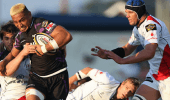 3:57
3:57
Advanced Passing Skills
Passing skills are a high priority for most coaches and teachers. This video features a "Grip Game" to test the offloading skills and ball control of players
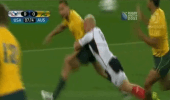 0:15
0:15
Men's - Offloads 2
A counter attack invlving moving the ball wide quickly, then attack defenders with support runners and finally a 2 v 1 to score in the corner. Key factors : Strong communication - Wide spin passes - Attacking the space around defenders - Support the ball carrier from behind - Offload with two hands - straight running - Flat pass
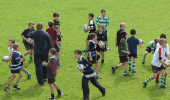 1:24
1:24
Passing in Grid
Players move around in a grid passing to each other. A gentle warm up that is easy to grasp if you have a mixture of talent levels. Involves communication and some handling. Progress to include placing the ball on the ground, then another player picking it up. This is another basic skill that also involves a gentle stretch. You can adapt this with any progression you wish.
 3:55
3:55
Farrell & Ford - Spin Passes
The quality of passes from Ford and Farrell to enable Elliot Daley to slide past his defender was the difference in the Wales V England match. The skills required to perfect these passes were honed on the training ground over several years. See what type of drills they did and still do
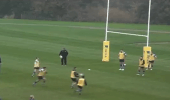 0:58
0:58
Passing in 4s - variations
Adding variations to a basic lateral passing drill is a solid foundation to build into strike moves. Players should concentrate on pass accuracy and the timing and direction of their running lines. Add defenders to progress.
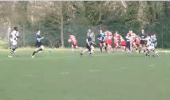 0:48
0:48
Offloads - Keeping the ball alive
In this clip, Eton College keep the ball alive through a series of offloads and long passes, deep within their 22. Eventually a gap emerges for them to exploit, finishing off the the try with a final offload.
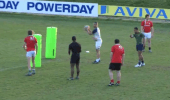 0:44
0:44
Learning to spin pass 1
Stand side-on to progress towards the lateral pass. Push the ball rather than swinging so your hand is pointing to the target after the ball has been passed. Maintain soft hands when catching the ball
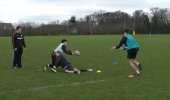 1:04
1:04
Offloading technique
Here's an example of a simple but effective 2v1 drill to practice the offload. Players concentrate on staying strong and getting their shoulders through contact, with the ball remaining in two hands. Support players communicate their position and time their run.
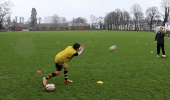 4:43
4:43
Coach the Scrum Half Pass
This clip outlines some of the fundamental techniques required to become a good passer of the ball from the ground, an essential skill for scrum half's. Simple and easy instructions for both coaches and players to benefit from
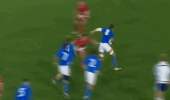 0:40
0:40
IRB Men's - Offloads 3
A quick lineout allows players to attack a "broken field" defence. Running at space moves the defenders and the suport player comes from depth behind the attacker to score. Key factors : Loud communication - Accurate spin pass - Attacking space - Trail support - Pop pass - Quick running
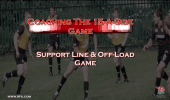 2:46
2:46
L2 - Support Line Breaks & Offloads
Skill Practice Description • The game begins with touch tackles. • Once tackled the ball carrier is allowed to step beyond the tackle line and the support from either side run toward (or attack) the ball. • The pass must be delivered behind the tackle line and not put back in front of the defence, so speed and decision making is vitally important. • Develop the game to grip tackles below the rib cage so the ball can be off loaded. • Progress to full tackles and the ball carrier must fight to keep the ball available. • The support must be aggressive in attacking the ball and getting between and beyond defenders. • When in full contact and the ball carrier cannot off load immediately, rucks and mauls may be played. Key Coaching Points • The game relies on good support play in all areas. This game illustrates the need for consistent and aggressive support. • The supporting players need to work for the ball carrier and attack the ball, getting in behind the defence for an off load. • Once the tackle line has been breached the attack must not allow the defence time to reorganise. • When progressed to full contact, the demand on decision making increases
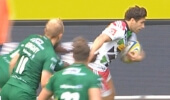 5:02
5:02
Fun Offloading Game!
Ball control is the key element to an effective offload. Jim Evans from Harlequins uses some fun games to coach this skill
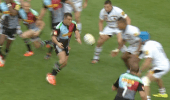 4:50
4:50
Improve your passing
Harlequins pride themselves on their attacking play and the foundation to this philosophy is the quality of their passing. Attack coach Colin Osbourne runs skills session on passing accuracy.
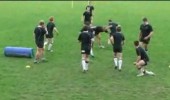 0:27
0:27
One handed offload out of the tackle
Develop a players ability to make an effective pass under pressure with support players trailing
 5:00
5:00
Simple Passing Exercises & Games
The Wasps coaches use a mixture of games and drills to develop the passing skills of young players. Players are encouraged to respond to questions. Games are used to improve the learning experience
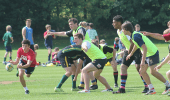 6:41
6:41
Scrum-half Passing Exercises
Some useful exercises for scrum-halves to develop their passing skills.
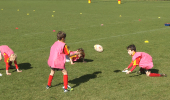 1:27
1:27
Passing Warm-up Game
A passing game that encourages quick hands to catch out team-mates. Include press-ups to include a bit of upper body warm-up as well.
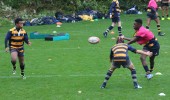 6:03
6:03
Timing the Pass
This exercise looks to develop the decision-making around the timing of a pass, and highlights running at pace and holding depth.
 3:05
3:05
Pre-Season Offload Touch For Fitness
This Pre-Season touch game is based upon offloading however there are other conditions which make it an ideal practise to combine skills and fitness
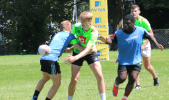 3:10
3:10
QBE - Support Line Breaks & Offloads
Support Line Breaks & Offloads
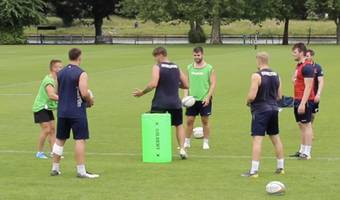 5:01
5:01
Offloading Progressions
Here's a great exercise from London Scottish with some excellent progressions taking you through catching difficult balls as well as some fun games to try.
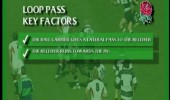 1:05
1:05
The Loop Pass - the Key Points
To review the coaching points of the loop
 0:50
0:50
The Miss Pass Key Coaching Points
To review handling Key factors
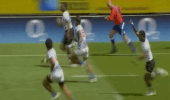 0:58
0:58
Sevens - Offloads 1
Sevens - Offloads 1
 1:02
1:02
The Loop pass - basic drill
To develop handling skills
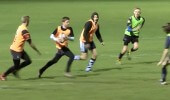 1:10
1:10
Using Games to Develop Passing and Support
Using games to coach is how most Premiership coaches improve skills and especially decision making. In this clip Jon Curry uses some clever rules to encourage supporting lines to help keep the ball alive
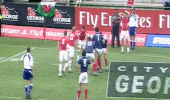 0:38
0:38
Sevens - Full Lineout 3
Accurate skills are the key to lineouts in seven's, a combination of movement, lifting and throw combine to make an effective restart for the attacking team. The shape of the attacking side is pre planned to create a mis - match with a faster player v a slower one. key factors : Pre call the move - Fast feet - Strong core for jumper - Support from both players to lift the jumper - Jumper to jump - Accurate throw - Support he jumper to the ground - Offload pass to scrum half
L2 - Support Line Breaks
Skill Practice Description • The objective is to increase the commitment to supporting a line break. • The teams play continuous touch, grip or tackle. • Stage 1: when a score is made all attacking players must touch the try line within 3 seconds or the try is disallowed and a turn over is awarded. • Stage 2: when a try is scored all attacking players must touch the ball on the ground within 5 seconds or the try is disallowed and a turnover is awarded. • Play starts again direct from the try line. • The coach may split the defence so cover defenders can challenge the effect of support play once the first line has been breached. Key Coaching Points • Encourage supporting players to angle toward the line break and not stay wide and lateral. • Encourage all attacking players to react and support a line break. • Speed of reaction. • Communication and team work
CCRU Game - Passing Pairs
Aim of the game: In pairs, walk, jog or run around the grid, passing to their partner only when they call for the ball. Other players will be obstructing their vision and the flight of the pass, so decisions on when to pass will need to be developed
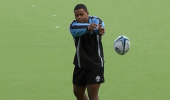 5:42
5:42
Expert Passing
Elite Sixth form players showcase that good passing technique is essential to become a good rugby player. The pass has some simple but very important components that need to be practised
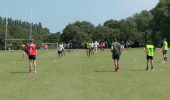 6:00
6:00
Passing and Support Lines
This clip shows the classic passing process but with a significant twist in what players can do post the pass
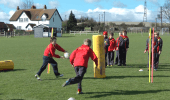 1:02
1:02
Passing - 2 v 1 Static Defender
Now working in just twos, we are concerned with depth, and the timing of the pass. Allow players to practice before adding a static defender. This can be a tackle bag as demonstrated. Players take the ball up to the defender but must complete the pass before they reach it.
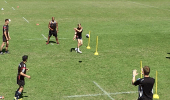 6:38
6:38
Practice Accurate passing
This clip reinforces the importance of passing and especially accurate passing. The coaches use a variety of practises to test the players skills and help them progress
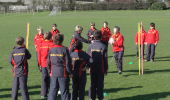 0:42
0:42
Passing Warm-up in 3s
A simple pass-along-the-line warm up. Work in lines of 3 and ensure you pass off both hands. There's no need to do this for too long, but it is useful to get players switched on to passing.
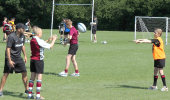 6:36
6:36
Coaching the spin pass
Saracens academy coach Rory Teague explains the basic principles of the spin pass including the exercises and progressions that can be used to help players improve their techniques and accuracy
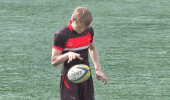 4:46
4:46
Ball Control & Passing
Controlling the ball is a fundamental skill, it may be simple but it is very important. Practise is important and is the foundation to passing and the ability to control and vary your pass
 6:58
6:58
Scrum half pass with Lee Dickson
Lee Dickson leads a passing session at the Northampton saints summer training camp. The focus is on doing the simple things well and progressing the practises to make things more challenging
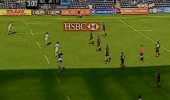 0:24
0:24
Sevens - Offloads 2
To execute an offload you need to have support players in the right area, here the ball carrier knows he has support and is able to take a risk and offload out of the back of the tackle. Prior to the offload the ball carrier works hard to stay on his feet. Key factor : Leg drive - Twist and work the body in contact - Control ball one handed - Communication from support players
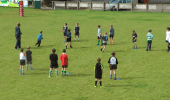 1:28
1:28
Passing in 4s
A basic handling drill for groups of young players with a mixture of talent. Emphasise technique, passing backwards, and running straight. As players become better they can try wider passes and add more pace. Encourage players to swap position. Counting the number of completed passes in a row challenges the players to never drop the ball.
 0:38
0:38
Fun passing game
Round the world passing challenge. Each player has a ball and they try and reach Ten passes of each hand. You can progress this by doing 1 pass to the left and then 1 to the right, then two to the left and so on until you get to 10, this is tough!!
 5:20
5:20
Teaching minis to pass backwards - full session
Learning to pass backwards is fundamental to rugby newcomers. This session brings minis out of a game for a few minutes to focus on that key skill, before taking them back into the game. Note the emphasis on questioning, development and how feedback changes depending on the ability of the child.
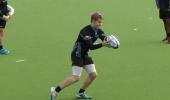 4:16
4:16
Catching is the First Skill of Passing
Being able to catch is fundamental to rugby and the majority of sports. Catching in rugby is slightly different due to the shape of the ball and understanding the technical points of "How to catch" is a very important area for all young players. This clip explains some of the finer points and why a good catch is the basis of a good pass
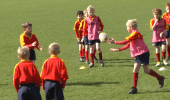 2:17
2:17
Passing in 2s
Working in pairs, the key point of this passing drill is for the support runner to be deep and taking the ball at pace.
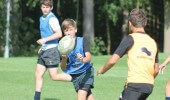 2:53
2:53
Passing Accuracy
Accuracy of passing can make the difference between finished chances or missed opportunities. In this video, Northampton Saints look at developing passing accuracy through games and focused exercises. Log in to see the full sessions.

Teaching minis to pass backwards
Learning to pass backwards is fundamental to rugby newcomers. This session brings minis out of a game for a few minutes to focus on that key skill, before taking them back into the game. Note the emphasis on questioning, development and how feedback changes depending on the ability of the child.
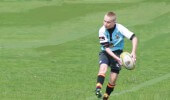 3:25
3:25
Passing Basics
This exercise is used by most coaches to identify a players passing and catching accuracy. The Northampton Saints coaches break down the skills required to ensure that "Simple things" are done well
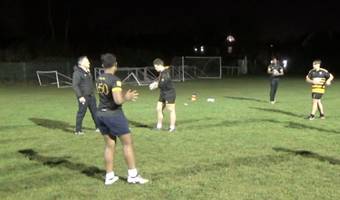 3:55
3:55
How To Push Pass - Simple Progressions
This video takes you through the basics of why and how we pass in Rugby! Use these explanations and simple progressions to help your players.
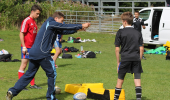 4:14
4:14
Scrum Half Passing with Chris Cusiter - Wrist Warm-Up
Sale Sharks and Scotland scrum half Chris Cusiter leads a session on passing from the base of a scrum or ruck. In this first video, Chris addresses basic technique in a couple of exercises that warm up the wrists and arms.
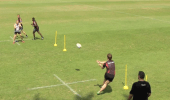 6:24
6:24
Quins - Developing An Accurate Pass
Coaching players to pass with variety and accuracy is one of the most important challenges a coach faces. The Harlequins academy players are presented with some very challenging exercises to help this process
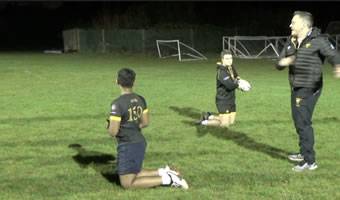 3:55
3:55
How To Push Pass - Simple Progressions
This video takes you through the basics of why and how we pass in Rugby! Use these explanations and simple progressions to help your players.
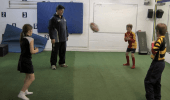 4:46
4:46
Home Training - Passing Challenges
Have some fun at home with some challenges passing games
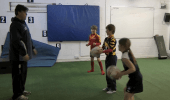 2:59
2:59
Home Training - Fun Catching & Passing Games
A variety of drills and games to practice and improve your catching & passing
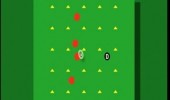 1:20
1:20
The Loop Pass - coaching points
To develop and progress the loop pass
 1:20
1:20
The MIss Pass - coaching tips
To develop the Miss Pass
 1:28
1:28
Passing - Basic principles
Working in waves of three, break down the components to catch and pass technique.
 1:01
1:01
JWC 2012: Forwards Passing
At the JWC 2012 is was clear that more forwards were passing the ball.
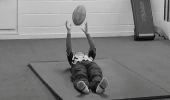 1:42
1:42
Improve Spin Passing at Home
Here are few exercises to help players of all ages improve their spin passing at home, even if there's no one else to practice with! As always, try to train your weaker hand so you have better options on the field.
 3:29
3:29
Learning to Pass - first steps
Young Brazilian players just learning the game start out with some smile passing exercise, this is perfect for any young player starting out in the game
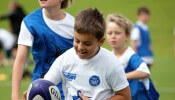 2:33
2:33
Three player passing challenge
A simple passing game that is fun and competitive. You can add more players in and vary the distance to make this harder or easier. Different balls could be used as well. Dad's can do this at home as a fun game
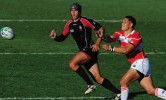 1:39
1:39
Skills at home - Learning to spin pass
Learning to spin pass is one of the first things young players want to do, it takes hours of practice and older / elite players continue practising throughout their careers. This video shows some simple exercises to do at home
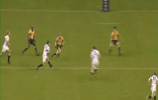 0:27
0:27
Core skills Miss Pass intro
To develop the core passing skills
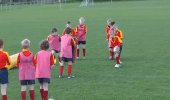 1:49
1:49
2 v 1 Passing
Adding a live defender helps to encourage players to hold their depth in support, so a good pass can be completed.
 2:57
2:57
Zig Zag Passing Challenge
This passing exercise is weird, extremely tough to do but will take your players out of their comfort zone and challenge them, can your players master it?
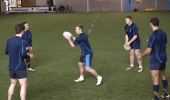 1:06
1:06
Stress Passing Challenge
Test the middle player with a circle of players who feed two balls in. The passing players MUST call the middle persons name and give a good pass otherwise this exercise will fail. This is great fun if managed properly and excellent for hand / eye
Warm up - 10 Pass Game
The 10 pass warm up game is excellent to introduce an activity that has a focus on dynamic mobilisation and raising the heart rate.
Players should be asked to focus on their special awareness, passing technique and communication.
To maximise participation, introduce another ball or split the game into two or three smaller games.
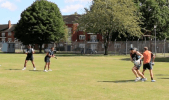 2:38
2:38
NSW Waratahs - Quick Passing
Southern hemisphere players pride themselves on their passing skills. In this clip, the NSW Waratahs go through some wide passing exercises.
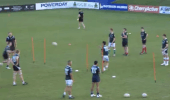 0:44
0:44
Learning to pass deep
Players must pass through gate before passing to supporting player before they reach the gate. This helps to ensure supporting players hold their depth and maintain a straight running line.
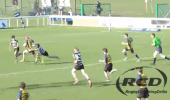 0:38
0:38
Leg drive and offloads
Staying strong in contact and using the leg-drive can commit extra defenders. If then, you can make an offload to supporting players, overlaps should be created. It is difficult to defend a strong offloading attack, and here, Stowe School are rewarded a try for their slick hands.
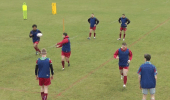 5:41
5:41
Catch & Pass Progressions
Passing progressions are based upon the ability of players to fix defenders. Always insure your exercises reflect match situations and refrain from just doing drills because they look good
 3:34
3:34
Passing Under Pressure
Being able to pass under pressure is how players perform in games. This exercise challenges players to react to multiple prompts and is great for all junior and senior players
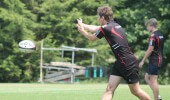 1:40
1:40
Quins - Accurate passing
Harlequins Academy go through a few exercises designed to improve passing accuracy. Premier members can log in now to see full sessions from Harlequins and other Premiership clubs.
7. 5 Pass Game
7. 5 Pass Game
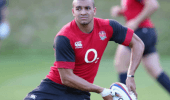 2:05
2:05
Quins - Out The Back Pass
The deep "Out The Back" pass is a play that is becoming more popular with several options and progressions. In this clip players from Harlequins run through a simple practise to improve their accuracy
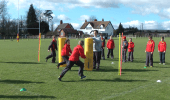 1:16
1:16
Passing - 3 v 2 Static Defenders
Progress to working in 3s against two static defenders. The pressure is on the middle player to hold their depth and perform a quick pass.
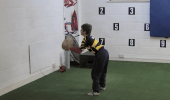 2:09
2:09
Home Training - Solo Passing
Practicing rugby skills at home can be difficult if there are no others to play with. But there are still things you can do by yourself if you have a ball handy. This exercise requires passing against a wall, developing accuracy, hand-eye co-ordination and problem solving. Also, check out our other videos on developing grip.
 0:20
0:20
What is a switch pass
Understanding the swith pass and why it is used
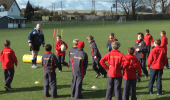 2:15
2:15
Passing - 3 v 2 Live Defenders
Gradually progress from 2 static defenders, to 3 v 2 roaming defenders. The first two players must draw their defenders before giving the pass.
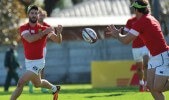 2:07
2:07
Home skills - Wall passing
Practising skills on your own can be tedious but using a wall to improve your passing can present some interesting challenges
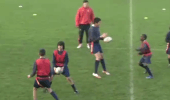 1:46
1:46
Passing in pairs
To get young players used to passing and catching the ball. This is best suited to a warm up exercise and get the players moving and active quickly
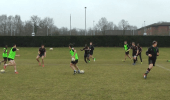 2:47
2:47
Pull back Pass
A clever exercise that keeps the players involved and moving constantly with an emphasis on depth and accurate passing. Players need to concentrate, communicate and be accurate if the drill is to continue. Coaches can add width, more players or in this example another ball to increase difficulty

